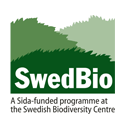Scientific Classification
Species in the Genus
Species in Kenya, Tanzania & Uganda
Description
Possible Causes of Confusion
Distribution in Kenya, Tanzania & Uganda
Habitats
Nesting
Crops Visited
Other Plants Visited
Economic / Ecological Importance
Threats
Conservation and Management Practices
Legislation (National and International)
References
Editors
Acknowledgements
Contact
Click on images to enlarge
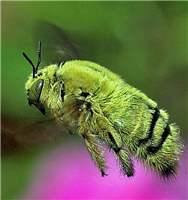
Xylocopa caffra. Photo by Ian Junor (CC BY-NC-ND)
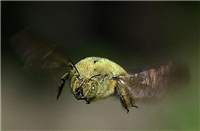
Xylocopa caffra. Photo by Ian Junor (CC BY-NC-ND)
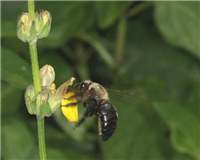
Xylocopa hottentotta. ©Bernhard Jacobi
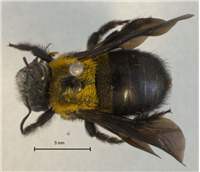
Xylocopa scioensis (female) - pinned specimen. Photo: Connal Eardley
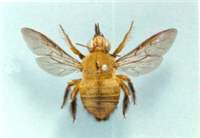
Xylocopa species (male) - pinned specimen. Photo: Connal Eardley
Summary
Honey bees are not the only bee species that are significant for human wellbeing. Xylocopa bees are a group of native bee species that do not produce honey but are important pollinators of crops and wild plants. Xylocopa bees do have quite a painful sting but they are not aggressive and will only sting for defence. Individuals live independently of the others (i.e. they are solitary) or in small groups. Xylocopa bees are larger than honey bees, hairy, often colourful and their wings make a loud buzzing sound while flying. Because of this conspicuousness they are well known in the region but are not known by the local people in
From a conservation and agricultural standpoint it is not necessary to recognise all the different bee genera. However, it is important to know that there is a large bee biodiversity. Different bee genera pollinate different plant species, although there is some overlap that acts as a buffer as bee populations wax and wane. For healthy ecosystems, including agro-ecosystems both diversity and abundance in the bee fauna is important.
Common Name (Language)
Carpenter bees, large carpenter bees, wood-cutter bees (English), bizunzuri (Luganda -
Scientific Classification
Kingdom: Animalia
Phylum: Arthropoda
Class: Insecta
Order: Hymenoptera
Family: Apidae
Subfamily: Xylocopinae
Tribe: Xylocopini
Genus: Xylocopa Latreille, 1802
Species in the Genus
The genus Xylocopa is a diverse, widely distributed group of solitary bees. Worldwide, there are about 500 species of carpenter bees representing 31 subgenera.
Species in Kenya, Tanzania & Uganda
It is likely that more than the 63 described Xylocopa species from
Description
Xylocopa bees are not known by the local people in
Possible Causes of Confusion
Some insect species particularly large beetles frequently encountered in tree trunks, could be confused with Xylocopa bees. Beetles have hardened fore-wings (elytra ) while bees have four membranous wings. Xylocopa bees can be confused with so called “Small carpenter�?. These bees belong to two distinct groups; Ceratina and several genera belonging to the tribe Allodapini. Ceratina bees have similar nests to Xylocopa, but they are much smaller. They are often heavily sclerotised (“armoured�?) with coarsely punctured (punctate), and sometimes metallic blue or green coloration. Several of the species of small carpenters belonging to the tribe Allodapini are social and most do not separate their nests into separate cells. Some are parasitic.
Distribution in Kenya, Tanzania & Uganda
Xylocopa bees are found in most districts/regions of
Habitats
Xylocopa bees can be found in various habitats (land-uses) in East Africa such as grasslands, natural forests, marshlands, open habitats, protected areas, farmlands, rangelands, woodlands, woodlots (forest plantations), riparian areas and coastal areas.
Nesting
Xylocopa bees live independently of the others (i.e. they are solitary) or in small groups. Xylocopa bees nest in tree trunks, in dead wood, bamboo, or structural timbers found in sheltered sites (Michener 2007). They construct their nests by boring tunnels in wood materials, which is how they get their common name. They vibrate their bodies as they rasp their mandibles (jaws) against the wood. Each nest has a single entrance which may have several adjacent tunnels. Xylocopa bees discard the wood fragments produced by their drilling or re-use these particles to build partitions between cells. The tunnel functions as a nursery for brood and storage for the pollen/nectar upon which the brood subsists. Some species tunnel in wood in homes but the structural damage is virtually non-existent as the tunnels are not deep. In several species, the females live alongside their own daughters or sisters, creating a semi-social group.
Crops Visited
Xylocopa bees collect nectar and pollen from various flowering crop species belonging to different plant families found in
Other Plants Visited
In
Economic / Ecological Importance
Xylocopa bees are important pollinators of open-faced flowers. Some crop species such as those in the genus Passiflora are completely dependent on Xylocopa bees for pollination (i.e. they are obligate pollinators). Large carpenter bees are also important pollinators of other fruit crops and pulse crops. They increase agricultural productivity and assist in the conservation of the natural biological diversity in the region.
Threats
In
Conservation and Management Practices
Little information exists on the usefulness of these bees to the lives of the people in
Legislation (National and International)
There is not yet any legislation in
References
1. Eardley CD, Gikungu M, Schwarz MP (2009) Bee conservation in Sub-Saharan Africa and
2. Eardley CD and Urban R (2010) Catalogue of Afrotropical bees (Hymenoptera: Apoidea: Apiformes). Zootaxa, 2455: 1–548.
3. Michener CD (2007) The Bees of the world, the John Hopkins University Press,
4. Eardley CD (1983) A taxonomic revision of the genus Xylocopa Latreille (Hymenoptera: Anthophoridae) in southern
5. Eardley CD (1987) Catalogue of Apoidea (Hymenoptera) in Africa South of the
6. Kasina M, Kraemer M, Martius C and Wittmann D (2009) Farmers' knowledge of bees and their natural history in Kakamega district,
Editors
Théodore Munyuli, Busitema University - Uganda; Muo Kasina, Kenya Agricultural Research Institute (KARI) - Kenya; Juma Lossini, Tropical Pesticides Research Institute (TPRI) – Tanzania; John Mauremootoo, BioNET-INTERNATIONAL Secretariat – UK; Connal Eardley, Plant Protection Research Institute (PPRI) – South Africa.
Acknowledgements
We recognise the support from the Kenya Agricultural Research Institute (KARI), Tropical Pesticide Research Institute (TPRI) –
Contact
BioNET-EAFRINET regional coordinator: [email protected]





